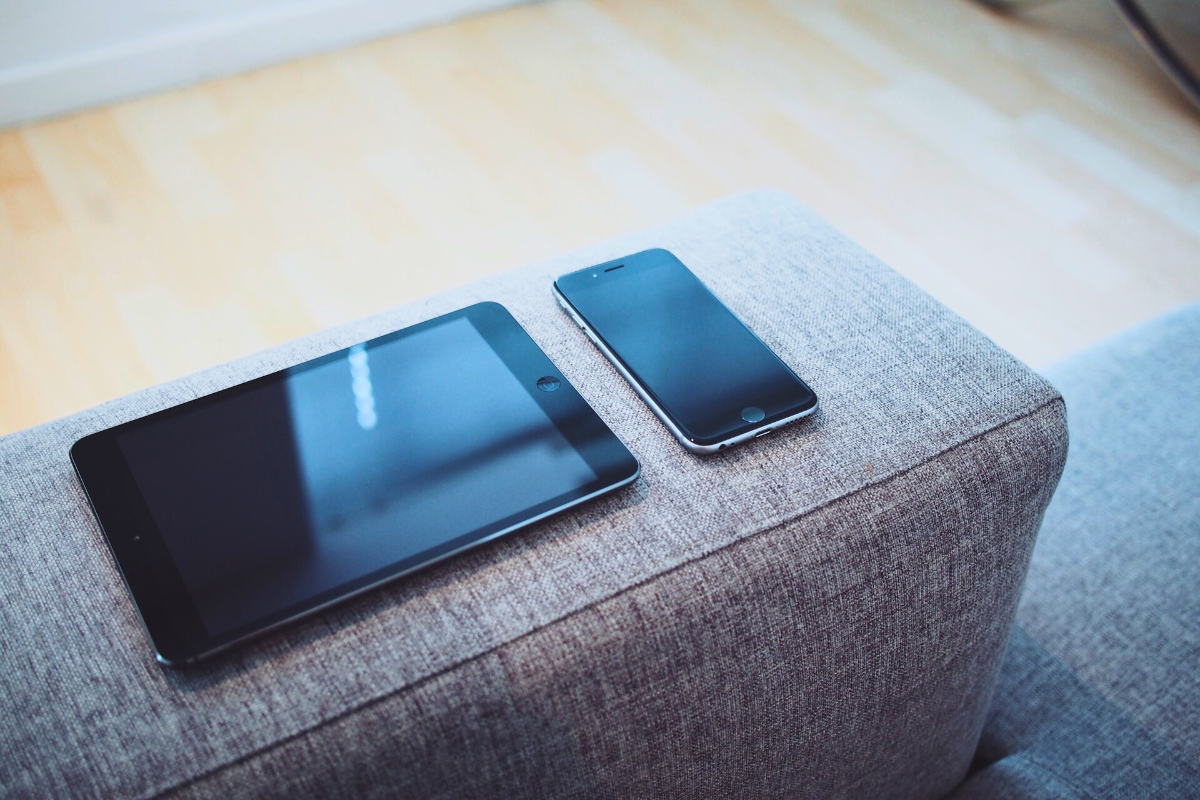Ensuring you have a backup of your iPad is crucial to safeguarding your valuable data.
One important task to learn is how to backup iPad effectively.
Regularly backing up your device provides protection against accidental file deletion, device malfunctions, or the unfortunate event of a lost or stolen iPad.
Fortunately, Apple offers convenient options such as iCloud and iTunes for creating backups of your iPad.
To back up your iPad using iCloud, you need a Wi-Fi connection and enough space in your iCloud account.
With iCloud, you can back up almost all data and settings on your device, including photos, contacts, messages, and app data.
You can also enable automatic backups, which will back up your device daily when it is connected to power and Wi-Fi.
However, iCloud backups do not include data that is already stored in iCloud, such as contacts, calendars, and notes.
Another option for backing up your iPad is using iTunes.
You can connect your iPad to your computer and use iTunes to back up your device.
iTunes backups include almost all data and settings on your device, and you can choose to encrypt your backup to protect your data.
However, you need to have enough space on your computer to store the backup, and you need to remember to back up your device regularly.
Table of Contents
ToggleWhy Backup Your iPad?
You might think that your iPad is safe and secure, but accidents can happen at any time.
There are various reasons why you should backup your iPad regularly. Here are some of the reasons:
Protect Your Data
Your iPad contains a lot of important data that you don’t want to lose.
This data includes your contacts, photos, videos, documents, and more.
If you don’t backup your iPad, you risk losing all this data in case your iPad gets lost, stolen, or damaged.
Easy Restore
Imagine losing all your data on your iPad, and you don’t have a backup.
You will have to start from scratch, which can be a daunting task.
However, if you have a backup, you can easily restore your data to a new iPad or your existing one.
iPhone And PC Compatibility
Backing up your iPad is not only limited to your iPad device.
You can also backup your iPad to your iPhone or PC.
This means that you can access your data from different devices and restore it whenever you need it.
Peace Of Mind
Backing up your iPad gives you peace of mind.
You don’t have to worry about losing your data or starting from scratch.
You can relax knowing that your data is safe and secure.
In conclusion, it is essential to backup your iPad regularly.
It protects your data, makes it easy to restore, and gives you peace of mind.
How To Backup iPad: Different Ways To Backup
Backing up your iPad is essential to ensure that your data is safe and secure.
There are several ways to back up your iPad, and in this section, we will discuss some of the most common methods.

Method 1: iCloud Backup
iCloud backup is the easiest and most convenient way to back up your iPad.
With a Wi-Fi connection, you can back up your device without having to plug it into a computer.
Here’s how to do it:
- Connect your iPad to a Wi-Fi network.
- Go to Settings > [Your Name] > iCloud > iCloud Backup.
- Turn on iCloud Backup.
- Tap Back Up Now.
Method 2: iTunes Backup
iTunes backup is another way to back up your iPad. Here’s how to do it:
- Connect your iPad to your computer using a USB cable.
- Open iTunes and click on the iPad icon.
- Click Summary.
- Click Back Up Now.
Method 3: Third-Party Backup Apps
There are several third-party backup apps available on the App Store that you can use to back up your iPad.
These apps offer additional features and flexibility compared to iCloud and iTunes backup.
Some popular third-party backup apps include:
- iMazing
- AnyTrans
- Dr. Fone
Before using a third-party backup app, make sure to read reviews and check the app’s compatibility with your iPad.
Method 4: External Hard Drive Backup
If you prefer to have a physical backup of your iPad, you can back up your device to an external hard drive.
Here’s how to do it:
- Connect your external hard drive to your computer.
- Open iTunes and click on the iPad icon.
- Click Summary.
- Under Backups, select This Computer.
- Click Back Up Now.
In conclusion, backing up your iPad is crucial to ensure that your data is safe and secure.
You can choose from several backup methods, including iCloud, iTunes, third-party backup apps, and external hard drive backup.
Choose the method that works best for you and make sure to back up your device regularly.
How To Backup Your iPad To iCloud
Backing up your iPad is an essential task that ensures your data is safe in case of device loss, damage, or theft.
iCloud provides a convenient way to backup your iPad data wirelessly and automatically.
In this section, we’ll guide you through the process of backing up your iPad to iCloud.

Step-by-Step Guide
Here’s how to backup your iPad to iCloud:
- Connect your iPad to a Wi-Fi network.
- Open the Settings app on your iPad.
- Tap your name at the top of the screen.
- Tap iCloud.
- Tap iCloud Backup.
- Toggle on iCloud Backup.
- Tap Back Up Now to start the backup process.
- Stay connected to your Wi-Fi network until the backup is complete.
It’s important to note that your iPad will automatically backup to iCloud when it’s connected to power, locked, and using a stable Wi-Fi connection.
You can also manually backup your iPad anytime by following the above steps.
Managing iCloud Backups
iCloud provides 5GB of free storage space, which may not be enough to backup all your data.
If you need more storage space, you can purchase a larger iCloud storage plan.
Here’s how to manage your iCloud backups:
- Open the Settings app on your iPad.
- Tap your name at the top of the screen.
- Tap iCloud.
- Tap Manage Storage.
- Tap Backups.
- Here, you’ll see a list of all your iCloud backups.
- Tap on a backup to see its details, including size and backup date.
- To delete a backup, tap Delete Backup, and then confirm your action.
Encrypting your iCloud backups is also an option to ensure your data is secure.
To encrypt your iCloud backup, follow these steps:
- Connect your iPad to a computer with iTunes installed.
- Click on the iPad icon in iTunes.
- Click Summary.
- Select “Encrypt local backup.”
- Type a password, then click Set Password.
In conclusion, backing up your iPad is an essential task that ensures your data is safe and secure.
With iCloud, you can backup your iPad wirelessly and automatically.
Make sure to manage your iCloud backups regularly to ensure you have enough storage space and to delete any unnecessary backups.
How To Backup Your iPad To iTunes
Backing up your iPad is an important step to ensure that your data is safe and secure.
iTunes is a great tool to use for backing up your iPad, and it’s easy to do.
In this section, we’ll walk you through the step-by-step process of backing up your iPad to iTunes, as well as managing your iTunes backups.
Step-by-Step Guide
- Connect your iPad to your computer using a USB cable.
- Open iTunes on your computer.
- Click on the iPad icon in the upper left corner of the iTunes window.
- Click on the “Summary” tab in the left-hand menu.
- Click on the “Back Up Now” button under the “Manually Back Up and Restore” section.
- If you want to encrypt your backup, check the “Encrypt local backup” box and create a password.
- Click “Back Up Now” again to start the backup process.
It’s important to note that the first backup may take a while, depending on how much data you have on your iPad.
Subsequent backups will be faster because only new or changed data will be backed up.
Managing iTunes Backups
Once you’ve backed up your iPad to iTunes, you may want to manage your backups to free up storage space or delete old backups.
Here’s how:

- Connect your iPad to your computer using a USB cable.
- Open iTunes on your computer.
- Click on the iPad icon in the upper left corner of the iTunes window.
- Click on the “Summary” tab in the left-hand menu.
- Scroll down to the “Backups” section.
- To delete a backup, click on it and then click “Delete Backup.”
- To manage your backup settings, click on the “Options” button next to “Automatically Back Up.”
- Here, you can choose to automatically backup your iPad to iCloud or your computer, as well as choose what data is backed up.
By following these simple steps, you can ensure that your iPad data is safe and secure.
Remember to backup your iPad regularly to avoid losing any important data.
How To Backup Your iPad To A Mac
Backing up your iPad is a crucial step in ensuring that your important data, files, and settings are protected.
In this section, we will discuss how to backup your iPad to a Mac using the Finder app or third-party apps.
Using Finder App
If you have a Mac running MacOS Catalina or later, you can use the Finder app to backup your iPad.
Here’s how:
- Connect your iPad to your Mac using a USB cable.
- Open the Finder app on your Mac.
- Select your iPad from the sidebar in the Finder app.
- Click on “General” in the top menu bar.
- Click on “Back Up Now” to start the backup process.
The backup process may take some time depending on the size of the data on your iPad.
Once the backup is complete, you can view the date and time of the last backup in the Finder app.
Using Third-Party Apps
If you prefer to use third-party apps, there are several options available.
One popular option is EaseUS MobiMover, which allows you to backup and transfer data between your iPad and Mac.
Here’s how to use it:
- Download and install EaseUS MobiMover on your Mac.
- Connect your iPad to your Mac using a USB cable.
- Launch EaseUS MobiMover and click on “Backup Manager”.
- Select the data you want to backup and click on “Next”.
- Choose the location where you want to save the backup and click on “Backup”.
EaseUS MobiMover will automatically backup your selected data to your Mac.
You can also use this app to transfer data from your Mac to your iPad or sync data between multiple Apple products.
Backing up your iPad is an important step in ensuring that your data is safe and secure.
Whether you choose to use the Finder app or third-party apps, make sure to backup your iPad regularly to prevent data loss and free up storage space.
How To Backup Your iPad To A Windows PC
Backing up your iPad is crucial to ensure that your data is safe and secure.
Here’s how you can backup your iPad to a Windows PC.
Using iTunes
iTunes is a free application that you can use to backup your iPad to your Windows PC. Follow these steps to backup your iPad using iTunes:
- Connect your iPad to your Windows PC using a lightning to USB cable.
- Launch iTunes on your PC.
- Click on the iPad button near the top-left of the iTunes window.
- Click on Summary in the sidebar.
- Below “Backups,” click on Back Up Now.
- To encrypt your backup, select “Encrypt local backup,” type in a password, and then click on Set Password.
- To see the backups stored on your computer, choose Edit > Preferences, then click on Devices.
Using Third-Party Apps
There are also third-party apps that you can use to backup your iPad to your Windows PC.
One of the most popular third-party apps is EaseUS MobiMover.
Here’s how you can backup your iPad using EaseUS MobiMover:
- Download and install EaseUS MobiMover on your Windows PC.
- Connect your iPad to your Windows PC using a lightning to USB cable.
- Launch EaseUS MobiMover on your PC.
- Click on Transfer to Computer.
- Select the items you want to backup and click on Transfer.
- Wait for the transfer process to complete.
In conclusion, backing up your iPad is important to ensure that your data is safe and secure.
You can use iTunes or third-party apps like EaseUS MobiMover to backup your iPad to your Windows PC.
How To Manage Your iPad Backups
Backing up your iPad is essential to ensure that your valuable data is safe and secure.
However, over time, these backups can take up a lot of storage space on your computer or in iCloud.
In this section, we will show you how to manage your iPad backups, including deleting old backups and restoring from backups.

Deleting Backups
If you have multiple backups of your iPad, you may want to delete the old ones to free up storage space.
Here’s how to delete backups:
- Deleting iCloud Backups: To delete an iCloud backup, go to Settings > iCloud > Manage Storage > Backups. Here, you will see a list of all the backups associated with your Apple ID. Tap on the backup you want to delete and then tap Delete Backup.
- Deleting iTunes Backups: To delete an iTunes backup, open iTunes on your computer and go to Edit > Preferences > Devices. Here, you will see a list of all the backups stored on your computer. Select the backup you want to delete and click Delete Backup.
Restoring From Backups
If you need to restore your iPad from a backup, you can do so using either iCloud or iTunes. Here’s how to restore from backups:
- Restoring from iCloud Backups: To restore from an iCloud backup, go to Settings > General > Reset > Erase All Content and Settings. Follow the on-screen instructions until you reach the Apps & Data screen. Here, select Restore from iCloud Backup and sign in to your iCloud account. Choose the backup you want to restore from and wait for the process to complete.
- Restoring from iTunes Backups: To restore from an iTunes backup, connect your iPad to your computer and open iTunes. Select your iPad from the list of devices and click Restore Backup. Choose the backup you want to restore from and click Restore.
Managing Storage
If you’re running out of storage space on your iPad, you can manage your storage by deleting unnecessary files and data. Here are a few tips:
- Delete Unused Apps: Go to Settings > General > iPhone Storage and scroll down to see a list of all the apps installed on your iPad. Tap on an app to see how much storage it’s using and then tap Delete App to remove it.
- Offload Unused Apps: If you don’t want to delete an app permanently, you can offload it instead. Go to Settings > General > iPhone Storage and tap on an app. Here, you will see an option to Offload App. This will remove the app from your iPad but keep its data and documents.
- Delete Old Messages: Messages can take up a lot of storage space on your iPad. Go to Settings > General > iPhone Storage > Messages and tap Review Large Attachments. Here, you can delete any large attachments that you don’t need.
In conclusion, managing your iPad backups is essential to ensure that your data is safe and secure.
By following the tips and tricks outlined in this section, you can delete old backups, restore from backups, and manage your storage effectively.
Tips For iPad Backup And Security
Backing up your iPad is crucial to ensure that you don’t lose any important data.
Here are some tips to help you backup your iPad and keep it secure.
Encrypting Your Backup
Encrypting your iPad backup is an important step in securing your data.
When you encrypt your backup, you will need to enter a password to access your backup data.
To encrypt your backup, connect your iPad to your computer and open iTunes.
Click on the iPad button and then click on Summary. Under the Backups section, select “Encrypt local backup” and enter a password.
Syncing Your iPad
Syncing your iPad with iTunes is another way to backup your data.
When you sync your iPad, iTunes will create a backup of your data.
To sync your iPad, connect it to your computer and open iTunes.
Click on the iPad button and then click on Summary.
Under the Options section, select “Sync with this iPad over Wi-Fi.”
Updating Your iPad
Updating your iPad is important to ensure that you have the latest security patches and features.
To update your iPad, go to Settings > General > Software Update.
If there is an update available, tap on “Download and Install.”
Managing Your iPad Storage
Managing your iPad storage is important to ensure that you have enough space for your data.
To manage your iPad storage, go to Settings > General > iPad Storage.
Here, you can see how much space is being used by each app and delete apps that you no longer need.
In addition, you can also manage your iPad storage by offloading unused apps.
To offload an app, go to Settings > General > iPad Storage and select the app that you want to offload.
Then, tap on “Offload App.”
In conclusion, backing up your iPad is important to ensure that you don’t lose any important data.
By following these tips, you can keep your iPad secure and ensure that you always have the latest features and security patches.
Key Takeaways
Backing up your iPad is an important task that should be done regularly to ensure that your data is safe in case of any unforeseen circumstances.
Here are some key takeaways to keep in mind when backing up your iPad:
- Use iCloud backups: iCloud backups are a convenient and easy way to back up your iPad. With a Wi-Fi network connection, you can back up your device using iCloud. You don’t need to plug your device into a computer to back up with iCloud. iCloud backups include nearly all data and settings stored on your device. iCloud backups don’t include data that’s already stored in iCloud, such as Contacts, Calendars, and Notes.
- Use iTunes backups: You can also back up your iPad using iTunes on your computer. Connect your iPad and your computer with a cable, open iTunes, and click the iPad button near the top left of the iTunes window. Click Summary, and then click Back Up Now (below Backups). To encrypt your backups, select “Encrypt local backup,” type a password, and then click Set Password. To see the backups stored on your computer, choose Edit.
- Consider using Google Drive: If you prefer to use a cloud-based backup solution, you can use Google Drive. Google Drive offers 15 GB of free storage, which should be enough for most users. To back up your iPad to Google Drive, download the Google Drive app from the App Store, sign in with your Google account, and then upload your files to Google Drive.
- Frequently Asked Questions: If you have any questions about backing up your iPad, check out the Apple Support website. They have a comprehensive list of frequently asked questions that can help you troubleshoot any issues you may be having. Additionally, you can find helpful tips and tricks on their website to help you optimize your iPad’s performance.
By following these key takeaways, you can ensure that your iPad is backed up and your data is safe.
Whether you choose to use iCloud, iTunes, or Google Drive, make sure to back up your iPad regularly to avoid losing any important data.











